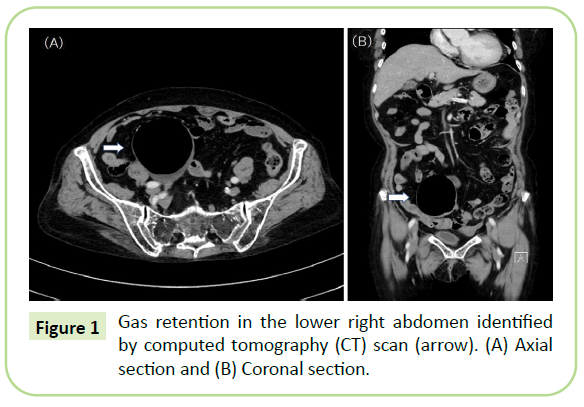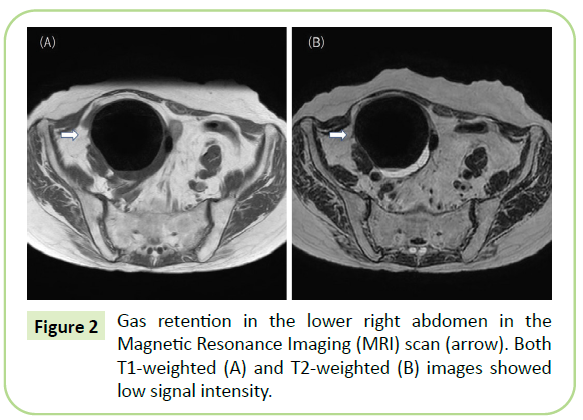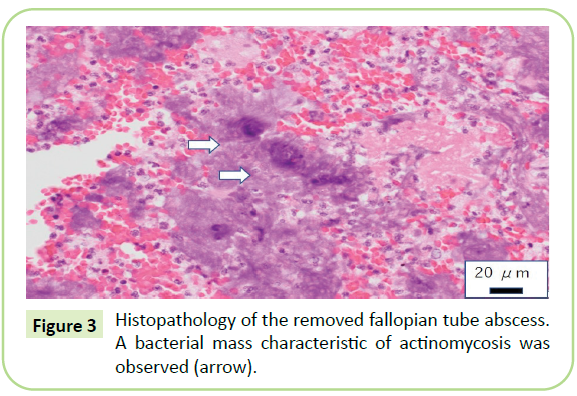Yoshida K*, Kashima K, Koda Y, Suzuki M, Honda K and Kazama Y
Department of Obstetrics and Gynecology, Uonuma Institute of Community Medicine, Niigata University Medical and Dental Hospital, Uonuma Kikan Hospital, Minami-Uonuma, Japan
- *Corresponding Author:
- Yoshida K
Department of Obstetrics and Gynecology
Uonuma Institute of Community Medicine
Niigata University Medical and Dental Hospital
Uonuma Kikan Hospital 4132 Urasa
Minami-Uonuma 949-7302, Japan
Tel: +81 25 777 3200
E-mail: kunihiko5083@gmail.com
Received Date: June 22, 2021; Accepted Date: July 13, 2021; Published Date: July 20, 2021
Citation: Yoshida K, Kashima K, Koda Y, Suzuki M, Honda K, et al. (2021) Actinomycosis of the Fallopian Tube with Gas Inside: A Case Report. Gynecol Obstet Case Rep Vol.7 No.7:145.
Keywords
Actinomycosis; Tubo-ovarian abscess; Laparoscopic surgery
Introduction
Actinomycosis of the adnexa is a rare infection mainly caused by the anaerobic gram-positive rod Actinomyces israelii, and is a chronic condition that presents with abscesses and fistulas. However, no previous reports have described fallopian tube infections presenting with gas retention. We report a rare case in which imaging examinations showed no features of abscess, intestinal perforation, or malignant tumor, and only gas retention was observed in the adnexa. Subsequent laparoscopic surgery revealed a fallopian tube abscess, which was resected, and the pathological examination revealed actinomycosis.
Case Report
The patient was a 71-year-old woman, para two. She had autoimmune cerebellar ataxia and was taking prednisolone 10 mg. She also had steroid-induced diabetes and an adrenal tumor. In a follow-up Computed Tomography (CT) examination for the adrenal tumor, a cavity with dimensions of 61 × 73 × 72 mm was observed in the right side of the abdominal cavity, and intestinal perforation was suspected (Figure 1). She was subsequently referred to the obstetrics and gynecology department.
Figure 1: Gas retention in the lower right abdomen identified by computed tomography (CT) scan (arrow). (A) Axial section and (B) Coronal section.
She had no fever or abdominal pain at the time of the visit. Transvaginal ultrasound showed fluid retention in the uterus, but no lesions could be identified in the cavity in the lower right abdomen. Blood tests showed a leukocyte count of 7900/μl (neutrophils, 78.5%), Carcinoembryonic Antigen (CEA) level of 4.3 ng/ml, carbohydrate antigen (CA) 19-9 level of 0.4 U/ml, and normal ranges of inflammatory reactions and tumor markers. No significant abnormalities were found in other values.
We performed Magnetic Resonance Imaging (MRI) one month after the CT scan for a detailed examination. MRI revealed a 74 × 74 × 93 mm air reservoir in the right ovary (Figure 2). Abscess formation or intestinal perforation could not be clearly identified, and the cause of the air retention was unknown at that time. In addition, there were no solid parts suspected of being malignant tumors.
Figure 2: Gas retention in the lower right abdomen in the Magnetic Resonance Imaging (MRI) scan (arrow). Both T1-weighted (A) and T2-weighted (B) images showed low signal intensity.
The lesions tended to grow, and the patient occasionally experienced lower abdominal pain, so she decided to undergo surgical removal. We performed laparoscopic surgery two months after the CT scan. During the operation, marked swelling of the right fallopian tube was observed. The right fallopian tube showed adhesions to the mesentery and broad membrane. When the right adnexa was detached from the surrounding adhesions, pus outflow was observed. Bilateral adnexal removal was performed except for a part of the right ovary, which had strong adhesions. In addition, the abdominal cavity was thoroughly washed, and the operation was completed. The patient showed no complications such as infection after the operation and was discharged 5 days after the operation. At a later date, a histological diagnosis revealed an abscess in the right fallopian tube, indicating the possibility of actinomycosis (Figure 3). No malignant tumors were noted.
Figure 3: Histopathology of the removed fallopian tube abscess. A bacterial mass characteristic of actinomycosis was observed (arrow).
One month after the surgery, based on the results of histological diagnosis, the patient received 1000 mg/day of oral amoxicillin for two months. Bacterial culture tests of the intrauterine fluid and vaginal discharge were performed before initiation of oral administration. Bacteroides fragilis was cultured from the fluid in the uterus, and Streptococcus agalactiae was cultured from the vaginal discharge. A follow-up examination three months after the surgery showed a decrease in the fluid in the uterus, and antibiotic administration was terminated without any signs of infection. This report was deemed ethical by our institution's IRB review policy. Informed consent was obtained from the patient, including consent to participate and to publish the findings.
Discussion
Actinomycoses are chronic bacterial infections caused by grampositive anaerobic actinomycetes. Their symptoms resemble tuberculosis or nocardiosis, which cause abscesses and fistulas [1]. They can form tumors and are difficult to diagnose as malignant tumors. Although cultures are the most reliable method for definitive diagnosis of actinomycetes, identification of actinomycete cultures is extremely difficult. A previous report suggested that the detection rate of actinomycetes was 8% for Pap smears and 2% for cultures [2]. Therefore, in many cases, actinomycoses are diagnosed by histopathological assessments after surgery and identification of characteristic bacterial masses. In addition, pelvic actinomycetes are associated with opportunistic infections and long-term placement of intrauterine devices (IUDs) [3]. Although gas retention inside the fallopian tube due to actinomycoses has not been reported to date, actinomycoses of the mandible have been reported to be accompanied by gas retention in imaging examinations [4]. In this case, although the patient did not have an IUD, she had a history of steroid diabetes [4].
Tubo-Ovarian Abscesses (TOAs) are usually polybacterial [5]. Chlamydia trachomatis, Neisseria gonorrhoeae, Escherichia coli, and anaerobes are the most commonly involved pathogens. Gasforming infections are usually caused by anaerobic microorganisms such as Clostridium, Bacteroides, or one of the aerobic coliforms [6]. However, in practice, gas formation is rarely seen in infection of the adnexa [7]. Several cases of pneumoperitoneum due to ruptured TOA have been reported [8-10]. In addition, one case report described gas-induced cyst formation in the ovary [11]. However, our search of the literature yielded no reports describing gaseous cysts in the fallopian tube without an abscess on diagnostic images, as in this case. We presume that worsening of TOA with gas retention will result in rupture of the abscess and pneumoperitoneum. The present case was considered to be a rare instance where the gas cyst in the fallopian tube was accidentally identified in imaging examination before TOA worsened. In this case, Bacteroides fragilis was detected by the culture of the fluid in the uterus. Bacteroides fragilis is a common non-Clostridium gas-producing bacterium [6]. We considered the possibility of gas retention due to ascending polybacterial infection of the fallopian tube.
In addition to TOA, ovarian tumors can also cause gas retention in the ovary. Malignant tumors of the ovary or fallopian tube may invade the intestinal tract [12], and result in gas retention that may be seen in the ovary. The presence of gas retention inside the ovaries or fallopian tubes should thus alert clinicians to the possibility of malignant tumors. In this regard, cases of mature teratoma with intestinal perforation have also been reported [13].
The treatment modalities for actinomycoses include drug therapy and surgery. Effective drugs against actinomycetes include penicillin, tetracycline, macrolides, and lincomycin. Although long-term high-dose administration of penicillin is generally used, actinomycosis can present with strong granulation, necessitating a combination of surgical and antibiotic treatments. Since the actinomycete lesion appeared to have been removed in the present case, the patient received amoxicillin for two months, but a slightly longer administration period may have been more preferable.
Conclusion
In conclusion, gas retention in the adnexa with actinomycosis is a rare phenomenon. However, since gas retention may occur due to an abscess, intestinal perforation, or malignant tumor, it is important to investigate the cause of gas retention by imaging examination or laparoscopic surgery.
Acknowledgment
We gratefully acknowledge the work of past and present members of our department.
Disclosure
The authors have been no conflict of interest relevant to this article.
References
- Valour F, Sénéchal A, Dupieux C, Karsenty J, Lustig S, et al. (2014) Actinomycosis: Etiology, clinical features, diagnosis, treatment, and management. Infect Drug Resist 7: 183-197.
- Hager WD, Douglas B, Majmudar B, Naib ZM, Williams OJ, et al. (1979) Pelvic colonization with Actinomyces in women using intrauterine contraceptive devices. Am J Obstet Gynecol 135: 680-684.
- Burkman R, Schlesselman S, McCaffrey L, Gupta PK, Spence M (1982) The relationship of genital tract actinomycetes and the development of pelvic inflammatory disease. Am J Obstet Gynecol 143: 585-589.
- Sasaki Y, Kaneda T, Uyeda JW, Okada H, Sekiya K, et al. (2014) Actinomycosis in the mandible: CT and MR findings. AJNR Am J Neuroradiol 35: 390-394.
- Chan Y, Parchment W, Skurnick JH, Goldsmith L, Apuzzio JJ (1995) Epidemiology and clinical outcome of patients hospitalized with pelvic inflammatory disease complicated by tubo-ovarian abscess. Infect Dis Obstet Gynecol 3: 135-139.
- Nichols RL, Smith JW (1975) Gas in the wound: What does it mean? Surg Clin North Am 55: 1289-1296.
- Thomassin-Naggara I, Darai E, Bazot M (2012) Gynecological pelvic infection: What is the role of imaging? Diagn Interv Imaging 93: 491-499.
- Chang CC, Hsieh YY, Tsai HD, Lin CC (2002) Tubo-ovarian abscess presenting as pneumoperitoneum. J Assist Reprod Genet 19: 42-43.
- Aguilera F, Dabiri TO, Farkas DT (2018) Pneumoperitoneum caused by tubo-ovarian abscess in an elderly patient. J Surg Case Rep 11: 191-194.
- McClenathan JH, Dabadghav N (2003) Pneumoperitoneum secondary to ruptured ovarian abscess. J Am Coll Surg 196: 325.
- Hatada Y (2002) A case of an air–fluid level in the ovary. Clin Radiol Extra 57: 43-44.
- Esterson YB, Gaballah M, Grimaldi GM, Raj MH, Pellerito JS (2019) Ovarian dermoid cyst complicated by small bowel obstruction, entero-ovarian fistula formation, and malignant degeneration. Clin Imaging 56: 47-51.
- Walter AR, Nelken RS (2012) Benign cystic ovarian teratoma with a fistula into the small and large bowel. Obstet Gynecol 119: 434-436.




